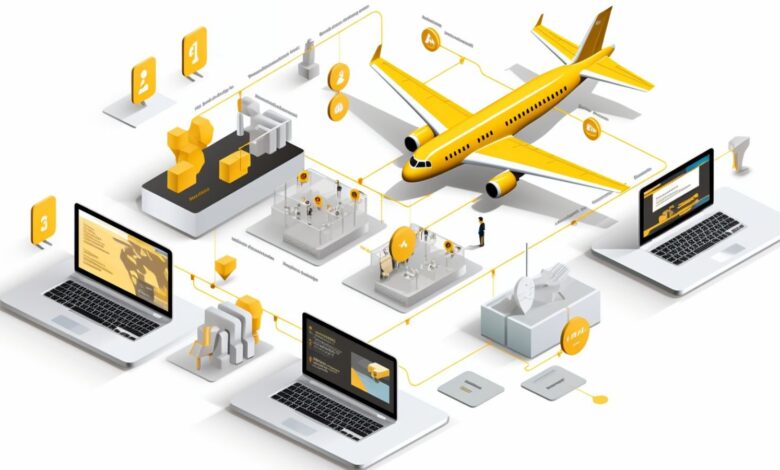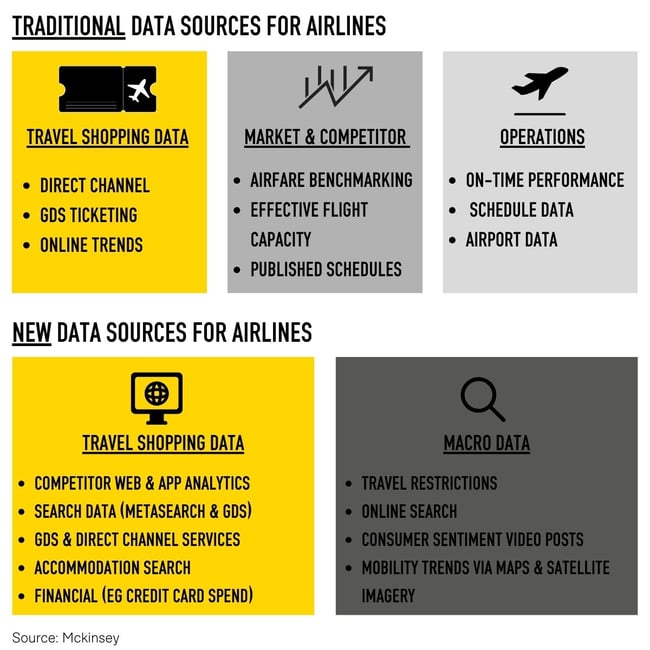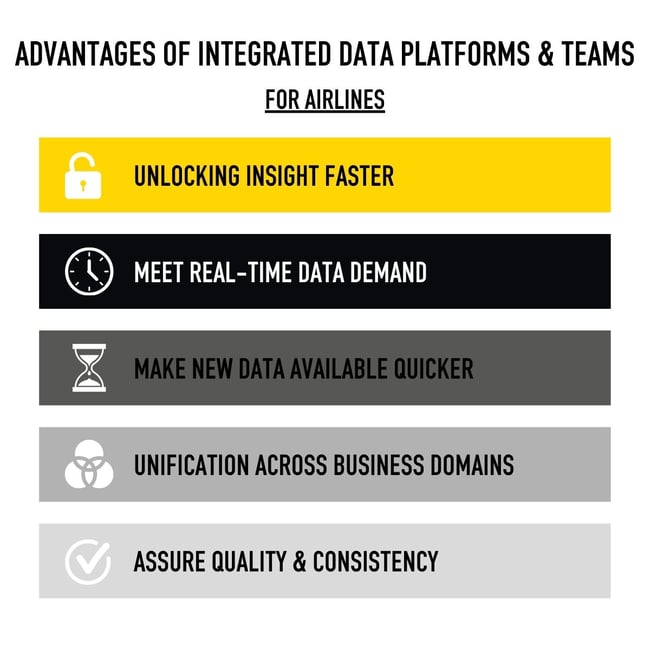The Evolving Role of Analysis and New Data

According to recent research the global aviation analytics market is anticipated to hit USD 4.36 billion by 2028 and exhibit a CAGR of 11.58% during that period. Data analytics is already an important and deeply embedded tool in the industry, but how will its role evolve as more options become available to airlines?
AIRLINE STRATEGY EVOLVES POST-COVID
First, let’s set the scene in the airline industry. The pandemic has allowed for all stakeholders in the aviation sector to reset their strategies, review future ambitions and use combinations of data to reassess their operations and aspirations for their businesses. With increased leisure time, revenge spending and changing attitudes to work/life balance, never has there been so much demand for air travel, so much change, and so many new entrants in the market.
Sacred assumptions and beliefs have been challenged and exciting new markets opened across both the legacy and low-cost airline segments. With new technology allowing for cost-effective single-aisle aircraft use with extended range, suddenly secondary markets such as Europe, Central Asia and the Americas are being opened, offering consumers more choice and airlines access to new revenue streams.
The market has embraced the transparency provided by NDC, (New Distribution Capabilities) which allows travelers to finally pay for only what they want. Ancillary revenues, streams, fintech development and the increasing use of relational databases are creating real insights for airlines on their customers and allowing them to maximize their ancillary revenues.
Sustainability is now the industry focus, with everyone from airline CEOs to operations staff constantly seeking to reduce carbon emissions, promote their green credentials and show that aviation is a valuable and effective contributor to global trade. This challenge will remain with us to 2050 and beyond. Small incremental steps supported by data sharing and deep analytics will help the industry reach its objectives of zero carbon emissions in time.
Something that hasn’t changed is the continued obsession with safety in an industry that provides the safest form of transport. Data sharing between airlines, AI analysis of millions of data points on any flight, ground operational data that enhances control processes and biometric security continues to evolve, but always from the perspective of safety first. No industry embraces data and technology for this purpose more effectively than the aviation sector.
THE ROLE OF DATA ANALYSIS FOR AIRLINES
As we’ve touched upon already, data and analysis have always been a critical part of making an airline successful and profitable. Data sits at the heart of the entire airline operation and is used by every department to help them perform in a highly-competitive and dynamic environment.
Revenue Management
By analyzing historical flight data, airlines can optimize pricing strategies and maximize revenue, considering factors such as demand patterns, customer preferences, and competitor pricing. With data analytics, airlines can dynamically adjust prices to match demand, ensuring maximum profitability.
Route Planning
Airlines can use data on passenger demand, travel patterns, and market trends to identify profitable routes and new routes, optimize their flight schedules and fit capacity to demand. Data analytics enables airlines to evaluate their profitability and make data-driven decisions on route expansion or contraction.
Predictive Maintenance
The right data can help airlines optimize maintenance schedules, ensuring aircraft are in the best possible condition while minimizing costs. By analyzing data from various sensors and systems on aircraft, airlines can identify potential maintenance issues before they become critical.
Risk Management
By analyzing data on safety incidents, weather patterns, and other risk factors, airlines can identify potential risks and take proactive measures to mitigate them. Trends and patterns may indicate potential safety risks, allowing for targeted interventions and improved safety measures.
Demand Forecasting
Airlines can use historical data and market trends to forecast demand for flights and optimize capacity. This helps airlines avoid overcapacity or undercapacity, ensuring that they can meet customer demand while maximizing revenue. Using historic data sets and experiences airlines can identify how to stimulate demand, respond to seasonal variations and effectively maximise revenues at all times of the year.
Identifying Key Performance Indicators
KPIs are crucial for airlines to measure their performance and make informed decisions. By analyzing various KPIs, such as load factor, on-time performance, and customer satisfaction, airlines can identify areas for improvement and implement strategies to enhance their operations.
NEW DATA AND NEW WAYS TO USE IT
Whilst tried and true traditional data sets and approaches will ensure many airlines can meet commercial expectations, those that are embracing new data sources and using data in different ways can gain the competitive advantage.
New – or alternative – data sources have emerged post-pandemic to address airline industry challenges. According to Investopedia, alternative data is defined as ‘’being gathered from non-traditional sources’’ and can include anything from comments on social media, weather forecasts and more. This data opens up new ways of looking at the aviation market, from passenger intent and behavioral influences to things like passenger spend.

WHY DO AIRLINES NEED NEW DATA?
The use of alternative data strategies has many benefits for airlines. Firstly, real-time insights can help airlines improve their operational efficiencies and ensure everything runs on time. For example, by using weather forecasts to plan operations or flight search data to gauge demand and set airfares accordingly. Alternative data can aid in providing a 360-degree view of the landscape.
In addition to this, throwing alternative data sets into the mix of traditional data analysis can provide a key competitive edge to the airline. By gaining more detailed insights, airlines can identify emerging trends, predict market shifts and get one step ahead of the competitor who is not using alternative data.
Another example of an alternative data strategy used by airlines is the analysis of social media trends and destination ‘virality’. By understanding ‘trending destinations’ or activities, airlines can target their marketing and route development plans accordingly. Social media can also provide insights into traveler preferences, booking patterns and behavior, enabling airlines to personalize marketing campaigns and optimize pricing strategies.
TRADITIONAL DATA – NEW APPROACHES
Traditional data such as Schedules, Flight Status, Traffic and Fares are still critical sources of information, but can be siloed, cumbersome and difficult to manipulate. Now, data analysis within airlines is getting a makeover as they seek to gain different insights, faster, and reduce manual effort and inconsistencies. In a recent article, we’ve explored how new technologies can combine traditional data like Schedules with new data sources such as weather information, to help airlines make flight route planning more efficient, safe and eco-friendly.
Traditional databases and airline systems were not designed to centralize, integrate, analyze and share extensive quantities of data across an organization, and data living in multiple silos can be difficult to streamline. The inability to share across departments can make collaboration challenging, and these are all reasons airlines look to move their data analysis to the cloud. With cloud technology and its in-built scalability and integration, it’s now possible to bring together previously siloed sets of data, layering them up to provide the context and insight needed to help airlines make informed decisions.
Here at OAG, we’ve helped a number of airlines transition their data analytics to the cloud environment of Flight Info Direct, powered by Snowflake.
WHY AIRLINES NEED INTEGRATED DATA PLATFORMS & DATA TEAMS

Many major airlines have sought to combine traditional and new data sources. This requires phasing out or adapting legacy technology in favour of a flexible data platform, which can make it easier to scale up and deliver insights to different functions across the airline in a variety of ways:
Unlocking Insights Faster
Accessing high level data becomes easier and functional teams don’t need to request and seek out data across the whole airline. This cuts down on duplication of effort and unnecessary delays, which means smarter decision making happens faster and with more profitable outcomes.
Meeting with Real-Time Data Demand
Real-time data can be used to optimize operations and enhance passenger experience by keeping everyone in the loop as and when events happen. More use cases for real-time data and opportunities to differentiate are driving a need for airlines to incorporate more, so the ability to handle larger volumes of data at velocity is critical to overall performance.
Making New Data Available Quicker
The time lag and cost in making new data available has previously been a barrier to innovation, but without cumbersome legacy technology and platforms, airlines can access a wider variety of data to experiment and create new insights. This leads to innovation in operations and product offerings.
Unifying Requirements Across Business Domains
Individual teams are no longer limited to using a multitude of dashboards from different vendors depending on the freshness of data and number of users. Access to the various data sets they need, when they need them and concurrently, means data management can be streamlined without duplicating workloads.
Assuring Quality and Consistency
How can teams across an organisation measure KPIs consistently when they’re accessing different data in different ways? Commercial, operational and customer teams can view the same data at the same time. An interconnected platform ensures any supply of increasingly complex data sets can remain consistent with airlines’ KPIs and analysis.
PARTNERSHIPS WITH ESTABLISHED DATA SPECIALISTS
For some airlines, the transition away from legacy technology may take longer. Transforming data infrastructure isn’t easy and requires investment and time. Larger airlines will undoubtedly create their own BI tools but for many operators a reliable tool with a trusted provider will serve them for many years to come. Airline intelligence platforms will continue to be the backbone of many teams that need high quality data, which is easy to consume in a user-friendly environment.
Airline data is getting more complex, the scale and volatility is increasing and creating new challenges. To stay ahead of the game, airlines need trusted partnerships to navigate this fast-changing landscape. They need quick, easy access to comprehensive data provided by data specialists who are up to speed on the latest thinking and technology, and backed up by years of experience and domain knowledge.
They need a customer-centric organisation that truly understands the value of their data and knows how to help an airline thrive. They need partners who can invest and innovate, with the freedom from bureaucracy and focus necessary to respond quickly to market need.
OAG has been leading innovation in airline data for decades. More than 900 airlines trust OAG with their data because it delivers value to the industry, invests for the future and enables transformation for its customers. Speak to a specialist and find out how we can help evolve your airline’s data analysis.



